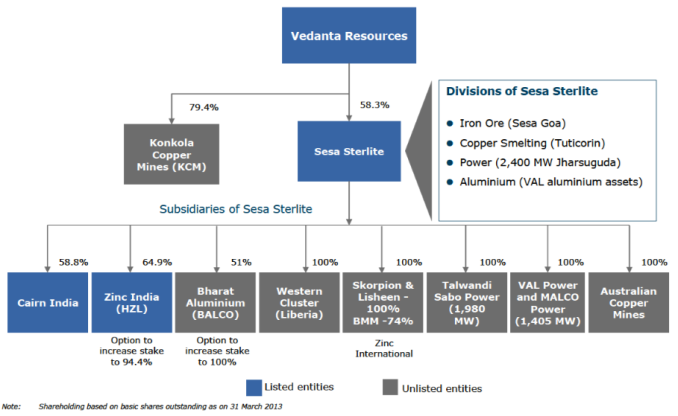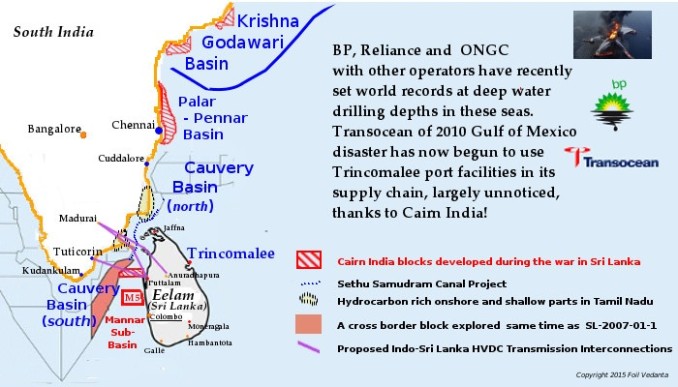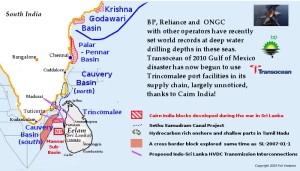 26th January 2015. Just five days before January’s Sri Lankan Presidential elections former Minister of Power and Energy Champika Ranawaka dropped a bombshell, accusing Mahinda Rajapaska’s government of failing to collect $7 billion in inflated share value from Cairn Energy – the first oil company to discover gas in the Mannar basin. His firey argument (aimed at shaming the then incumbent President) was that mineral exploration rights had been sold to British oil company Cairn Energy for a song following meetings between Rajapaksa and British Prime Minister Tony Blair (who was a school friend of Cairn Energy boss Bill Gammell) in 2006. In 2011, after gas was discovered in their Mannar block – SL 2007-01-001, the value of shares skyrocketed and Cairn Energy sold them on at a highly inflated value to Vedanta Resources, a British-Indian company, who bought Cairn Energy’s South Asian oil and gas subsidiary Cairn India, assisted by the British Prime Minister David Cameron.
26th January 2015. Just five days before January’s Sri Lankan Presidential elections former Minister of Power and Energy Champika Ranawaka dropped a bombshell, accusing Mahinda Rajapaska’s government of failing to collect $7 billion in inflated share value from Cairn Energy – the first oil company to discover gas in the Mannar basin. His firey argument (aimed at shaming the then incumbent President) was that mineral exploration rights had been sold to British oil company Cairn Energy for a song following meetings between Rajapaksa and British Prime Minister Tony Blair (who was a school friend of Cairn Energy boss Bill Gammell) in 2006. In 2011, after gas was discovered in their Mannar block – SL 2007-01-001, the value of shares skyrocketed and Cairn Energy sold them on at a highly inflated value to Vedanta Resources, a British-Indian company, who bought Cairn Energy’s South Asian oil and gas subsidiary Cairn India, assisted by the British Prime Minister David Cameron.
.
In July 2011, just before the sale to Vedanta, British Defence Secretary Liam Fox (whose mysterious company Sri Lanka Development Trust shared a building with Cairn Energy) visited Sri Lanka, and a few days later Basil Rajapaksa (Mahinda’s brother) led a decision to exempt Cairn Lanka from tax and import duties until 2016 and awarded a royalty rate of only 10%, causing uproar in the Sri Lankan parliament.
.
The entire Cairn India – Vedanta deal was worth $8.5 billion (at that time the largest transaction ever to take place in India) so it is hard to see how $7 billion can be owed to Sri Lanka, but Ranawaka also points out that in India the exchequer benefited around $1 billion from the transfer of Cairn India’s Rajasthan operations to Vedanta and asks why there was no such tax benefit in Sri Lanka. Though these figures remain disputed Ranawaka is right that the highly valuable resource has already disproportionally profited the two corporations, with very little coming back to the island’s residents, and the nation’s oil and gas is now out of its control and ownership.
.
In fact this is only a taste of what is to come for Sri Lanka (formerly known as Ceylon amongst many names, and referred to by the Tamil population as Eelam). Since the almost three decade old separatist war officially ended with the defeat of the Liberation Tigers of Tamil Eelam (LTTE) and importantly also the Sea Tigers in 2009, corporations are trampling over each other to get a piece of the pie in this resource rich, geo-strategically placed island. Cairn Energy and subsequently Vedanta are essentially the test cases, brave (or ruthless) enough to do business with a genocidal regime during the most brutal period of the war, and subsequently paving the way for shipping, oil and gas and hotel industries keen to profit from the fragile post war state, where land is easy to grab, especially in the Tamil coastal areas where state repression continues unabated and the struggle for self determination by Eelam Tamils is far from over.
.
In 2014 the Sri Lankan government teamed up withthe world’s biggest asset management company Blackrock – a major shareholder in the worlds top 30 companies, to promote investment in the island – holding “Invest Sri Lanka” forums in Mumbai, Dubai, Hong Kong, Singapore, London and New York. At the forums Sri Lankan representatives fell over themselves to assure corporations that there would be significant tax breaks for investors as well as no capital gains tax, and no restriction on repatriation of profits to foreign countries, as Cairn India has already discovered.
This article looks at the story of Cairn Lanka Private Ltd, the local subsidiary of Cairn India Limited; their increasing influence on the Sri Lankan state, and their corporate grab of the ‘Tamil Seas’ and ‘ Nithal nilam’ (meaning ‘land pertaining to sea’ in Tamil language) – the historic and bio-diverse coastlines on both sides of the Gulf of Mannar which defines the livelihood and culture of its Tamil communities.
.
Who are Cairn Lanka?
.
Cairn Lanka Private Limited (Cairn Lanka Pvt Ltd) is a wholly owned subsidiary of CIG Mauritius Pvt Ltd, controlled by Cairn India – Vedanta’s oil and gas subsidiary with production operations in Rajasthan and Andhra Pradesh and exploration in Gujarat, South Africa, Tamil Nadu and Sri Lanka. Cairn India is 58% owned by Sesa Sterlite, a major subsidiary of Vedanta Resources, registered in London. CIG Mauritius is a holding company registered in the island tax haven, which is in turn 100% owned by Volcan Investments in the Bahamas (another tax haven).9 Volcan Investments is the holding company controlled by Vedanta boss Anil Agarwal, through which he is the 69.9% owner of Vedanta Resources, making it in effect a private company as he controls shareholder decisions due to his large stake.
If this sounds highly complex, that’s because it is. But this corporate structure enables Vedanta to be pay a minimum of tax and facilitates related party loans and opaque transactions which maximise profit for the majority shareholder Mr Agarwal. In Zambia, a key member of the Commonwealth nations and a country ripped apart by privatisation and corporate takeover, Vedanta’s subsidiary Konkola Copper Mines was exposed in 2014 for evading massive amounts of tax by claiming that they were making a loss in Zambia, while boss Agarwal bragged of making between $500 million and $1 billion profit from the company at a business conference in India. Subsequent research by auditors discovered how copper and cobalt was being sold underpriced to a hidden subsidiary – Fujairah Gold, controlled by Agarwal’s son Agnivesh in Dubai, who then sold it on at a massive profit. This is called ‘transfer pricing’ and is a violation of the ‘arms length principle’.
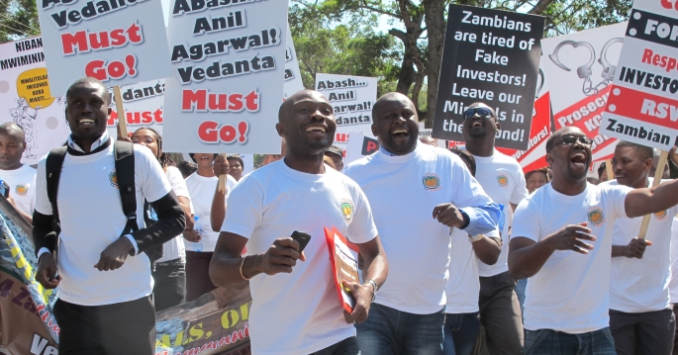 Protests demand Vedanta out of Zambia for tax dodging
Protests demand Vedanta out of Zambia for tax dodging
In Zambia, as in Sri Lanka, Vedanta have created deliberate confusion about the company’s nationality and the company name to manipulate perceptions and reduce their accountability. Zambians were under the impression that Vedanta was an Indian company, when in fact they are British registered and controlled. In Sri Lanka the names Cairn India, Cairn India Limited, Cairn Lanka Pvt Ltd and Cairn Energy are often used interchangeably.
,
In India the Supreme Court is currently hearing a central government plea that the merger of Vedanta subsidiaries Sesa Goa and Sterlite Industries to create Sesa Sterlite in 2012 was designed to evade tax by combining a profitable company with a loss making one, and has already resulted in a Rs 1600 crore tax refund request.
,
Vedanta is a high debt and high risk company which has historically used cash from profitable companies to service debt from unprofitable ones. In recent years it has borrowed large amounts from Indian State banks for failing companies which some analysts suggest may never be paid back. In July 2014 the profitable Cairn India loaned $1.25 billion to another Vedanta Group metals subsidiary without shareholder approval fielding accusations of conflict of interest from banks and shareholders.
,
Agarwal is now proposing to merge Cairn India, which has taken a hit due to recent oil price slumps, with Hindustan Zinc Ltd, another highly profitable subsidiary. Vedanta’s constantly shifting corporate structure needs to be understood in terms of tax and debt strategies – from hiding high debt companies with high profit ones, to possibly preparing the company structure for bankruptcy of certain low profit subsidiaries.
,
In January 2015 Vedanta Resources shares dropped to an all time low of 375p, from a high of 2919p in April 2009. The company has lost more than half its value in six months. Institutional investors like BlackRock Investments and Standard Life have sold millions of shares reducing the share of the company held by Institutional Investors (an important measure of corporate financial health) to only 15.6%. Vedanta now has a $16.9 billion debt and is having difficulty paying back loans.
Vedanta Resources is in many senses a family affair, with subsidiaries kept under tight control by Agarwal’s clan. This may have been one of the reasons that Cairn India directors Indrajit Banerjee and Rahul Dhir quit the board when Vedanta took over from Cairn Energy. Today’s Cairn India board includes Anil’s brother Navin Agarwal, daughter Priya Agarwal, as well as close allies Tarun Jain, banker Aman Mehta, former Infosys Director and former Chief Economist of the Confederation of Indian Industry, as well as advisor to the World Bank, IMF and OECD Dr. Omkar Goswami (who has expressed strong opinions against Human Rights Council investigations of the genocide in Sri Lanka), and powerful former Indian civil servant and Prime Minister’s advisor Naresh Chandra. Chandra, a long term Vedanta director was former Commonwealth Secretariat Advisor on Export Industrialisation and Policy in Colombo (1981-1984), and, along with Goswami and Mehta was also on the Cairn India board under Cairn Energy’s control since 2006, suggesting they played a key part in the change of hands. Chandra directs a number of major corporates and was once Cabinet Secretary of India as well as US Ambassador.
.
Cairn and the Sri Lankan state
The picture, much used by the Sri Lankan government as well as by Cairn Lanka and Cairn India, shows Mahinda Rajapaksa ceremonially inspecting what appears to be a Cairn ship in 2009. In fact, as the peeling sticker suggests, the ship does not in fact belong to Cairn but is seismic survey vessel SR/V Viking II, being operated by CGG Veritas and Hayleys Energy Services (HES). According to their website HES, run by former transport Secretary Dhammika Perera – the richest person in Sri Lanka under the Rajapaksa regime, “organized the inauguration [of 3D Seismic campaign] ceremony flagged off by HE the President Mahinda Rajapakse and attended by many dignitaries” and presumably stuck the Cairn logo on the ship for effect.
,
The promise of oil wealth was used by Rajapaksa extensively in hisoriginal 2005 election campaign and extensively during his Presidential tenure. At one time oil majors such as Indian state company ONGC, as well as Chinese and American companies were also bidding for oil and gas blocks, but by 2008 they had all pulled out except for Cairn. Cairn India’s block SL 2007-01-001 is located only 2.4 km from the Bar Reef Marine Sanctuary’s protected coral reefs off the Kalipiti(ya) coast, which are recently reported to be bleaching. These Tamil seas between Sri Lanka and Tamil Nadu and extending Northwards, geographically described as the Cauvery basin (see map), provide livelihoods for thousands of fishermen from both sides of the channel, and were a key region for the Sea Tigers during the civil war. Eradicating the sea tigers, then, was essential not just to win the conflict, but also to enable oil drilling and trawler fishing in the Tamil Seas. The recent report ‘Britain’s Dirty War on the Tamil People’ by Phil Miller details the involvement of the British military in training the Sri Lankan Navy in ‘sea security’ and ‘anti piracy’ during this period. In a January 2013 speech Cairn India’s Head of Corporate Affairs and Communications Dr. Sunil Bharati stated, “We appreciate the services carried out by the Sri Lanka Navy (security) and Sri Lanka Air Force (helicopter ferrying) both on commercial terms.”
.
Cairn’s position as the first oil company to brave tying up with the Sri Lankan regime must have brought it close to the government, who, as the picture shows, used this relationship as proof of the potential oil and Foreign Direct Investment (FDI) driven wealth to come. If the tax breaks agreed were going to bring little financial benefit to the island, Cairn and the Sri Lankan government did their best to show that Corporate Social Responsibility (CSR) would bring ‘development’. Cairn Lanka has been heavily involved in training the country’s state-run petroleum exploration unit, Petroleum Resource Development Secretariat (PRDS), donating equipment and sponsoring University places, as well as setting up libraries in remote areas in partnership with NGO ‘Room to Read’. The picture below, also used on Cairn Lanka’s website, shows the former President’s nephew and recently ousted Chief Minister of Uva Province opening one such library in Moneragala.
Sea grabs, pollution, and the Energy masterplan for Sri Lanka
Sri Lanka’s geostrategic importance and potential as an energy and shipping hub has long been recognised. Much of this centres on Trincomalee bay, the world’s third largest natural harbour, located on the Tamil inhabited East coast of Sri Lanka. During the colonial period it was fought over by the Portuguese, Dutch, British and French, and was described by Rear Admiral Horatio Nelson as the “finest harbour in the world” when he visited aboard HMS Seashore in 1770. Despite restrictions on its use under the 1987 Indo-Lanka Accord, former President Rajapaksa proposed converting it into another free port like Colombo and Hambantota.
.
The Masterplan for Sri Lanka set out by the previous government, and used to attract corporations in oil and gas, shipping, energy and tourism describes Sri Lanka as a new Singapore, a regional logistics, transshipment and energy hub, due to its strategic position on the major shipping route between China, India, the Middle East and Europe, as the map below shows.
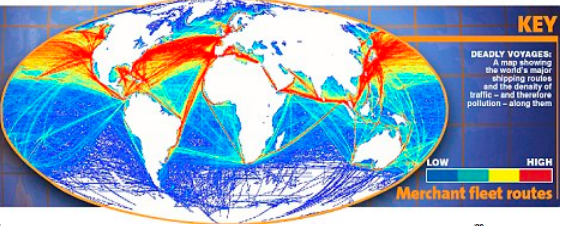 Global shipping routes, used to illustrate pollution from shipping associated sulphur.22
Global shipping routes, used to illustrate pollution from shipping associated sulphur.22
Again, Cairn and Vedanta’s risk taking has helped to pave the way for this ‘masterplan’, both by demonstrating the potential for doing business with Sri Lanka, and by kick-starting spin off enterprises associated with servicing the oil and shipping industries. For example in Colombobunker oil (or Heavy Fuel Oil – HFO), a highly polluting and dirty oil distillate used by the shipping industry is being stored and provided to Cairn by Lanka Marine Services (LMS). Trincomalee’s vast pre-Second World War tank farms are also being converted for oil bunkering by Indian Oil Corporation. Burning HFO gives off very sulphur rich fumes, and causes major pollution of the oceans, as demonstrated by the map above.
.
Dhammika Perera’s Hayleys Energy Services (HES), who organised the PR stunt with Rajapaksa and the stickered boat, are Cairn Lanka’s main subcontractor – supplying onshore storage, helicopters, fuel, and other logistics and admin. Hayleys are also being held responsible for major water pollution at Weliweriya, which was followed by protests in August 2013 during which the Sri Lankan military killed at least one protester and injured 15 more.
.
Another company called GAC also provide logistical support to Cairn India, including transhipment (stocking up ships and changing their cargo). In 2014 a deep drilling rig being used by Cairn India, but owned by Transocean (deep drilling specialists partly responsible for the Deepwater Horizon disaster) was erected at Trincomalee Bay using the extensive facilities onshore at the largely naval port (indicating the potential future use of this special harbour) and towed by GAC to the Ravva oil field in India.
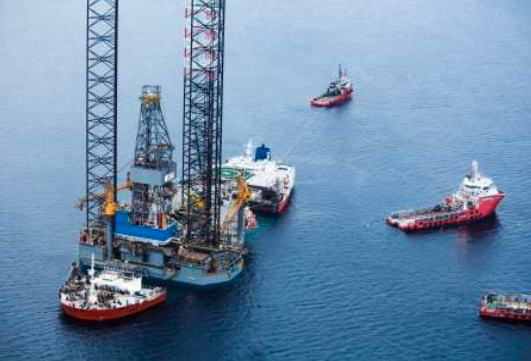 Hercules Triumph, the Transocean owned oil rig is towed from Trincomalee.
Hercules Triumph, the Transocean owned oil rig is towed from Trincomalee.
.
Cairn India have recently promised the supply gas to Ceylon Electricity Board’s thermal power plants (currently running on polluting Heavy Fuel Oil) by 2017/18 by undersea pipeline from their Dorado and Barracuda wells in Mannar. Imports of gas from their Indian operations may be used to top up this supply, for example from the Palar oil field in the Cauvery Basin just off the coast of Chennai, close to where BP, ONGC and Reliance have drilled the world’s deepest wells (see map). In the Krishna Godavari basin on the Andhra Pradesh and Tamil Nadu border and at their Rajastahn operations Cairn India have been making extensive use of dangerous fracking technology – including offshore fracking and Polymer flood injection. These ‘extreme energy’ techniques used to extract marginal reserves of oil and gas have been condemned by communities world over for causing severe pollution of water aquifers with toxic chemicals which are injected into the well to fracture rock, as well as creating minor earthquakes. Will Cairn be fracking in the Tamil Seas?
.
Water pollution is already becoming an urgent issue in the already water poor areas of Tamil Nadu and Sri Lanka. On the Tamil Nadu side of the Gulf of Mannar another of Vedanta’s operations – the Tuticorin copper smelter run by subsidiary Sterlite – is already polluting the narrow sea. The Tuticorin (Thoothkudi) port also provides uranium loading facilities for the contentious Kudankulam nuclear power station further down the Tamil Nadu coast. The industries have led to mass protests by fishermen and local people who oppose the pollution which is affecting their livelihoods. Meanwhile in Chunnakam near Jaffna in Northern Sri Lanka an Independent Power Producer called Northern Power Company, owned by a Colombo Stock Exchange listed firm MTD Walkers has polluted the main aquifer for Jaffna peninsula with Heavy Fuel Oil and waste leading to mass protests in January 2015 which claimed that this was simply another way of killing of Tamil people after the war. On 22nd January Energy and Power minister Ranawaka ordered the plant to be closed down following six years of pollution by waste oil, which is estimated to have affected over 1000 wells. Meanwhile Uthuru Janani – another hurriedly built power plant in the same Ceylon Electricity Board power generation complex in Chunnakam (which was connected to the national grid by then president Mahinda Rajapaksa in November 2013), continues to use HFO.
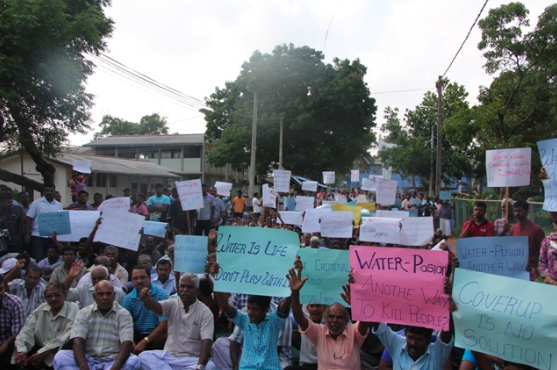 Mass protests following water pollution by MTD Walker at Chunnakam near Jaffna.
Mass protests following water pollution by MTD Walker at Chunnakam near Jaffna.
.
Under the proposed Sri Lankan masterplan, the surrounding seas could be choked with shipping traffic and oil rigs and the coasts covered in associated industries like oil bunkering, hotels, power companies, casinos, banks and tourism. Proposals to create a High Voltage Direct Current (HVDC) power transmission link between Indian and Sri Lankan energy grids are in the pipeline, and even the Victorian proposals to dredge the Sedusamudram Canal – the narrow, shallow point in the Palk Strait (named after 18th century governor of the Madras Presidency Robert Palk) that prevents large ships passing between Sri Lanka and India – are back in the news.
.
Preparing the corporate groundwork, USAID has helped set up CSR Lanka, a project to assist incoming corporates in carrying out reputation raising CSR, coordinated by a group of private companies in Sri Lanka .
.
A warning and a hope
In the clamour for post-war self determination, justice and peace in Tamil lands either side of the Gulf of Mannar, the rapid advance of another occupying force is not being fully noticed. Oil and gas companies, shipping, tourism and power suppliers backed by super-powered banks and investors like Blackrock and JP Morgan are closing in on Sri Lanka and the Tamil seas. The environmental and livelihood impacts of these industries onshore and at sea will be enormous, and could change the whole region beyond recognition. Successfully resisting this onslaught will require a massive effort to research and pre-empt developments, identify and unmask the key players and biggest profiteers, and coordinate communities affected by pollution and displacement, which is already starting to be felt.
.
In this article we have shared our existing research on Cairn Lanka Pvt Ltd, the Sri Lankan subsidiary of Cairn India, owned by the infamously abusive British-Indian corporate Vedanta Resources, which we argue has acted as a pioneer for the planned corporate invasion of the Tamil seas. It is hoped that this information will stimulate further investigations, interest and mobilisation around this issue – arguably as great a long term threat to the culture and livelihood of the Tamil people as the genocidal Sri Lankan regime.
9Financial Statements 2013-2014 CIG Mauritius Private Limited.
22 Fred Pearce, 21 November 2009. ‘How 16 ships create as much pollution as all the cars in the world’. The Daily Mail
newspaper.
